tire size TOYOTA 86 2019 Owners Manual
[x] Cancel search | Manufacturer: TOYOTA, Model Year: 2019, Model line: 86, Model: TOYOTA 86 2019Pages: 532, PDF Size: 6.89 MB
Page 243 of 532
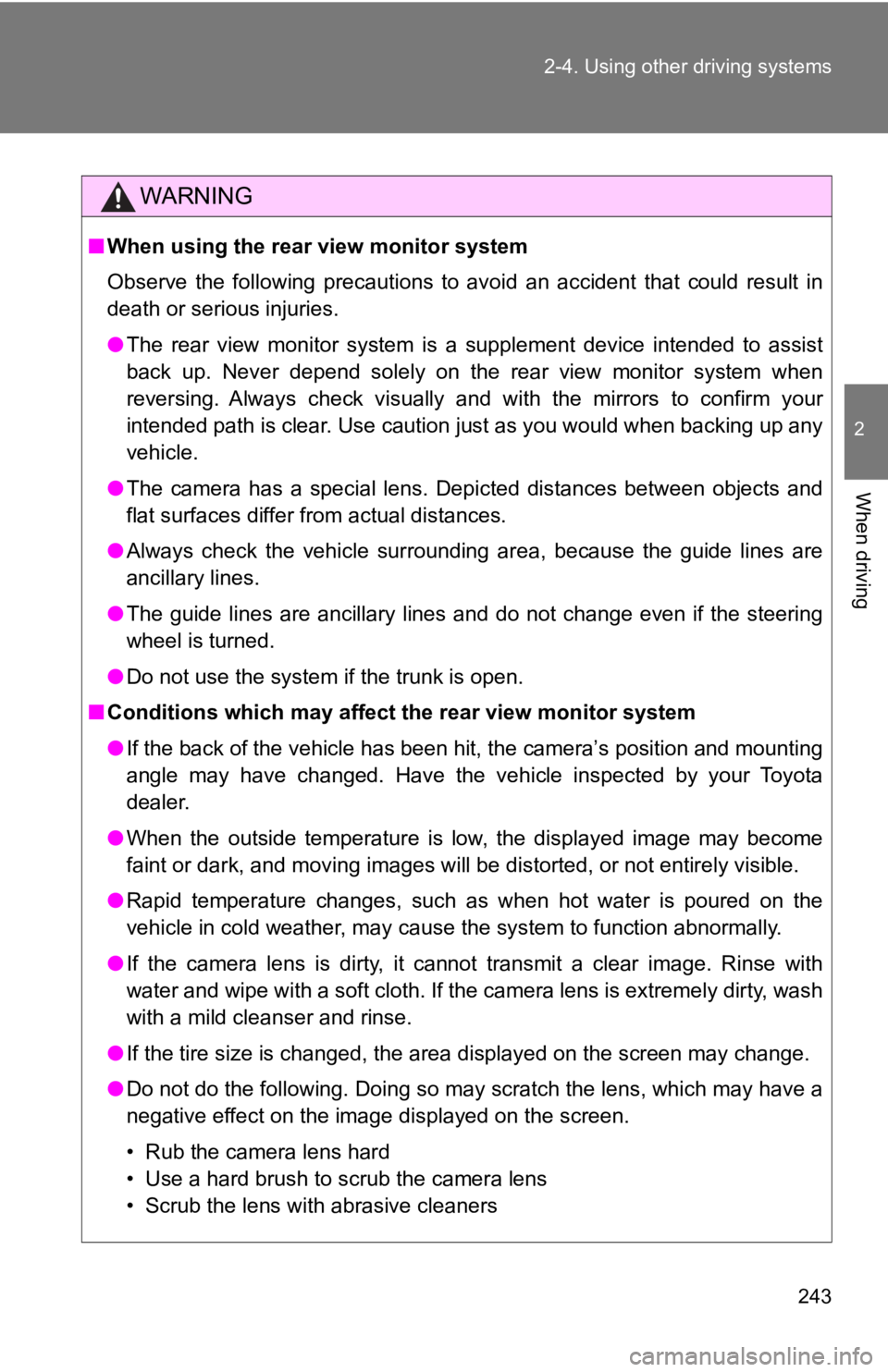
2432-4. Using other driving systems
2
When driving WARNING■ When using the rear view monitor system
Observe the following precautions to avoid an accident that cou ld result in
death or serious injuries.
● The rear view monitor system is a supplement device intended to assist
back up. Never depend solely on the rear view monitor system wh en
reversing. Always check visually and with the mirrors to confir m your
intended path is clear. Use caution just as you would when back ing up any
vehicle.
● The camera has a special lens. Depicted distances between objec ts and
flat surfaces differ from actual distances.
● Always check the vehicle surrounding area, because the guide li nes are
ancillary lines.
● The guide lines are ancillary lines and do not change even if t he steering
wheel is turned.
● Do not use the system if the trunk is open.
■ Conditions which may affect t he rear view monitor system
● If the back of the vehicle has been hit, the camera’s position and mounting
angle may have changed. Have the vehicle inspected by your Toyota
dealer.
● When the outside temperature is low, the displayed image may be come
faint or dark, and moving images will be distorted, or not enti rely visible.
● Rapid temperature changes, such as when hot water is poured on the
vehicle in cold weather, may cause the system to function abnor mally.
● If the camera lens is dirty, it cannot transmit a clear image. Rinse with
water and wipe with a soft cloth. If the camera lens is extreme ly dirty, wash
with a mild cleanser and rinse.
● If the tire size is changed, the area displayed on the screen may change.
● Do not do the following. Doing so may scratch the lens, which may have a
negative effect on the image displayed on the screen.
• Rub the camera lens hard
• Use a hard brush to scrub the camera lens
• Scrub the lens with abrasive cleaners
Page 251 of 532
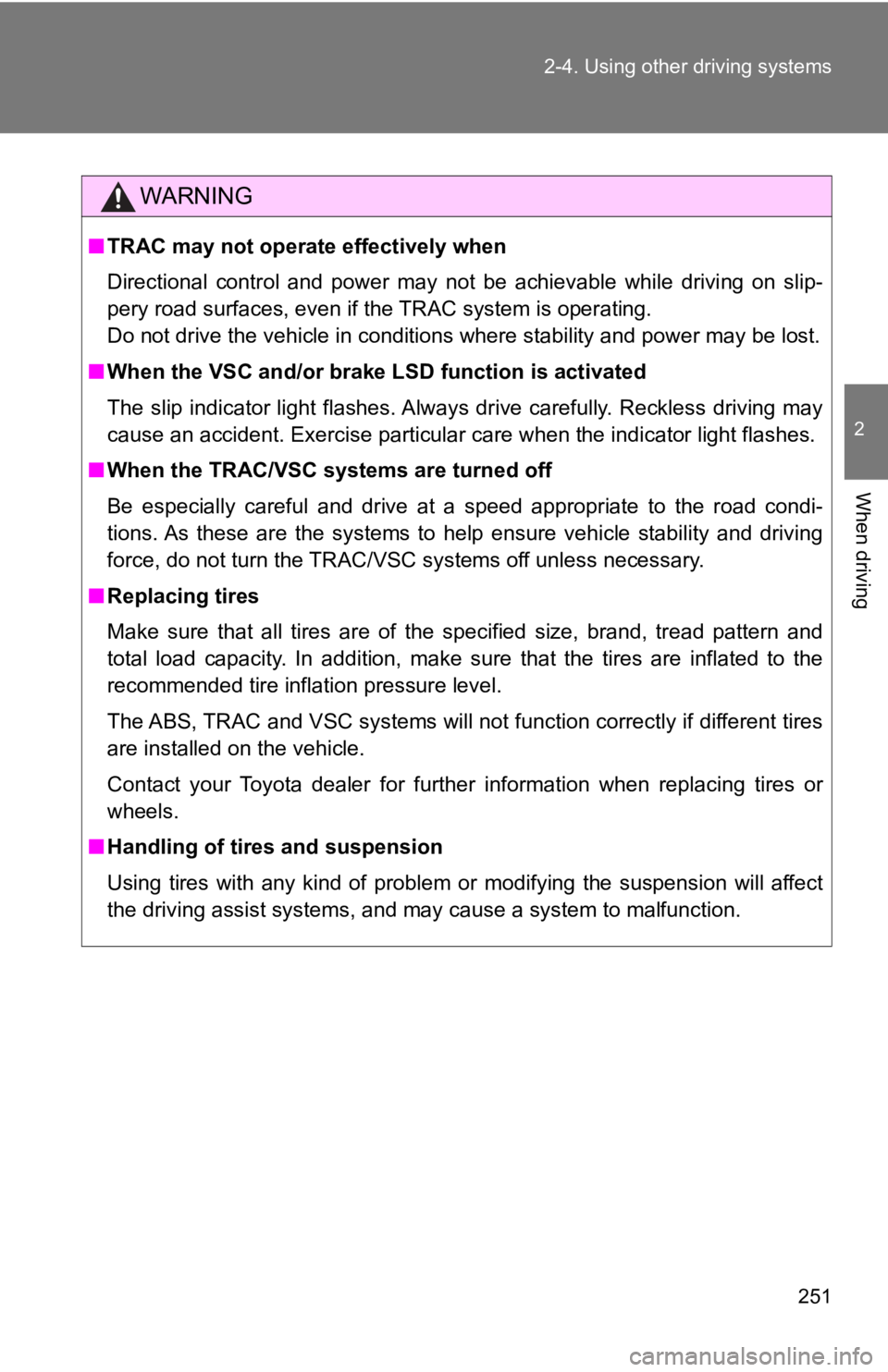
2512-4. Using other driving systems
2
When driving WARNING■ TRAC may not operate effectively when
Directional control and power may not be achievable while drivi ng on slip-
pery road surfaces, even if the TRAC system is operating.
Do not drive the vehicle in conditions where stability and powe r may be lost.
■ When the VSC and/or brake LSD function is activated
The slip indicator light flashes. Always drive carefully. Reckl ess driving may
cause an accident. Exercise particular care when the indicator light flashes.
■ When the TRAC/VSC systems are turned off
Be especially careful and drive at a speed appropriate to the r oad condi-
tions. As these are the systems to help ensure vehicle stability and driving
force, do not turn the TRAC/VSC systems off unless necessary.
■ Replacing tires
Make sure that all tires are of the specified size, brand, trea d pattern and
total load capacity. In addition, make sure that the tires are inflated to the
recommended tire inflation pressure level.
The ABS, TRAC and VSC systems will not function correctly if di fferent tires
are installed on the vehicle.
Contact your Toyota dealer for further information when replaci ng tires or
wheels.
■ Handling of tires and suspension
Using tires with any kind of problem or modifying the suspensio n will affect
the driving assist systems, and may cause a system to malfuncti on.
Page 261 of 532
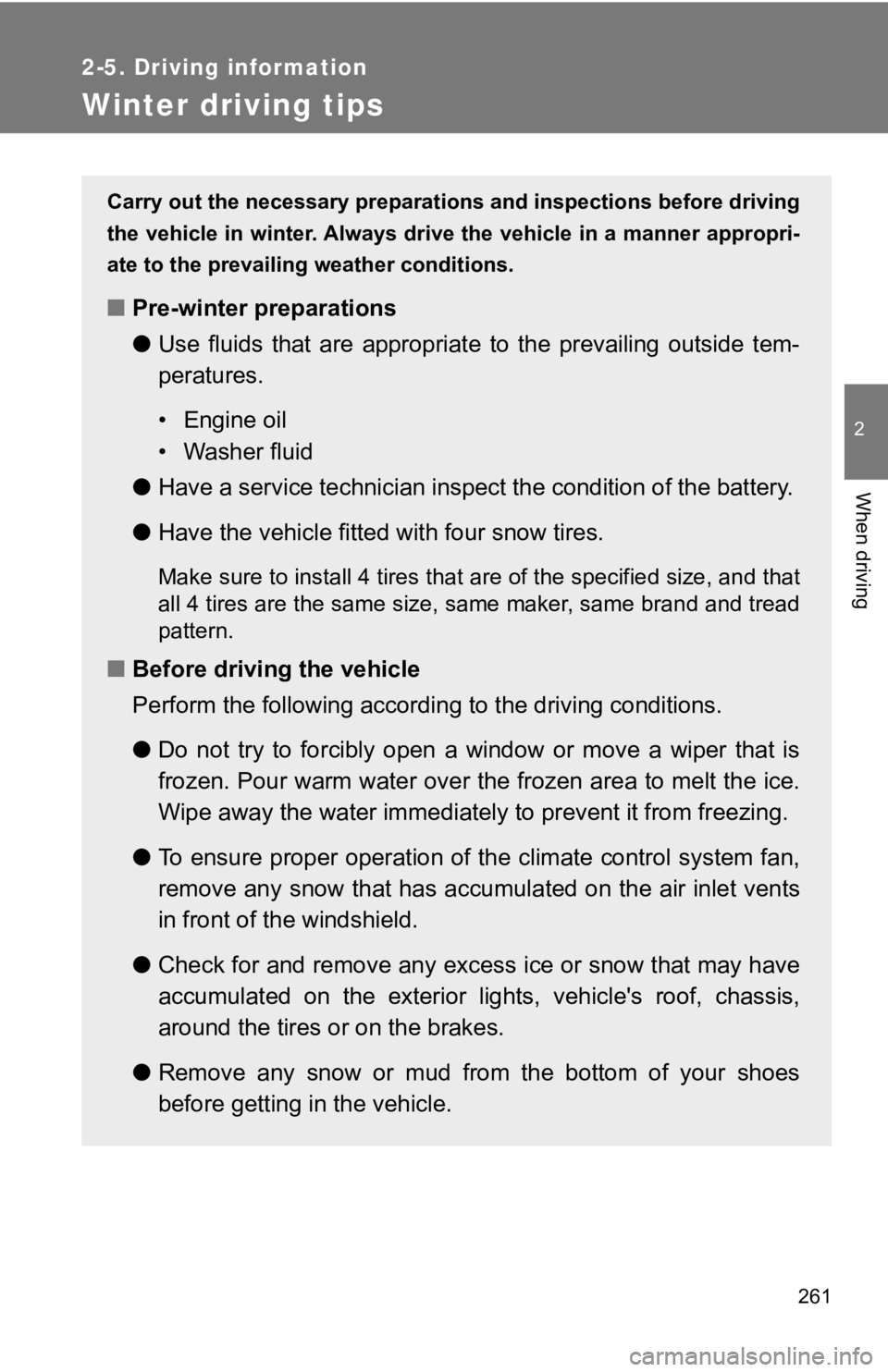
2612-5. Driving information
2
When driving
Winter driving tips Carry out the necessary preparatio ns and inspections before dri ving
the vehicle in winter. Always drive the vehicle in a manner app ropri-
ate to the prevailing weather conditions.
■ Pre-winter preparations
● Use fluids that are appropriate t o the prevailing outside tem-
peratures.
• Engine oil
• Washer fluid
● Have a service technician inspec t the condition of the battery.
● Have the vehicle fitted with four snow tires.
Make sure to install 4 tires that are of the specified size, an d that
all 4 tires are the same size, same maker, same brand and tread
pattern.
■ Before driving the vehicle
Perform the following accordi ng to the driving conditions.
● Do not try to forcibly open a window or move a wiper that is
frozen. Pour warm water over the frozen area to melt the ice.
Wipe away the water immediately to prevent it from freezing.
● To ensure proper operation of the climate control system fan,
remove any snow that has accumulated on the air inlet vents
in front of th e windshield.
● Check for and remove any excess ice or snow that may have
accumulated on the exterior lig hts, vehicle's roof, chassis,
around the tires or on the brakes.
● Remove any snow or mud from the bottom of your shoes
before getting in the vehicle.
Page 263 of 532

2632-5. Driving information
2
When driving Tire chains
Tire chains cannot be used on your vehicle because of the lack of
clearance between the tires and vehicle body.
When tire chains cannot be used, use of another type of tractio n
device (such as spring chains) may be acceptable if use on your vehi-
cle is recommended by the device manufacturer, taking into acco unt
tire size and road conditions.
Follow the device manufacturer's instructions, especially regar ding
maximum vehicle speed.
To help avoid damage to your vehicle, drive slowly, readjust or
remove the device if it is contacting your vehicle, and do not spin your
wheels. Damage caused to your veh icle by use of a traction devi ce is
not covered under warranty.
Make certain that any traction device you use is an SAE class “ S”
device, and use it on the rear wheels only.
Always use the utmost care when driving with a traction device. Over-
confidence because you are using a traction device could easily lead
to a serious accident.
Selecting tire chains
We recommend that you consult your Toyota dealer for informatio n
about the chains t hat you can use.
Page 264 of 532

2642-5. Driving information
WARNING■
Driving with snow tires
Observe the following precautions to reduce the risk of acciden ts.
Failure to do so may result in a loss of vehicle control and ca use death or
serious injury. ●
Use tires of the specified size, and that are the same size, sa me
maker, same brand and tread pattern. ●
Maintain the recommended level of air pressure.●
Do not drive in excess of 75 mph (120 km/h), regardless of the type of
snow tires being used.●
Use snow tires on all, not just some wheels.
NOTICE■
Repairing or replacing snow tires
Request repairs or replacement of snow tires from Toyota dealer s or
legitimate tire retailers.
This is because the removal and a ttachment of snow tires affect s the
operation of the tire pressure wa rning valves and transmitters.
■
Fitting tire chains
The tire pressure warning valves and transmitters may not funct ion cor-
rectly when tire chains are fitted.
Page 347 of 532

3474-3. Do-it-yourself maintenance
4
Maintenance and care ■
When to replace your vehicle’s tires
Tires should be replaced if: ●
The treadwear indicators are showing on a tire.●
You have tire damage such as c uts, splits, cracks deep enough t o
expose the fabric or bulges indicating internal damage●
A tire goes flat repeatedly or cannot be properly repaired due to the
size or location of a cut or other damage
If you are not sure, consul t with your Toyota dealer.■
Replacing tires and wheels
If the ID code of the tire pressure warning valve and transmitt er is not
registered, the tire pressure w arning system will not work prop erly. After
driving for about 20 minutes, t he tire pressure warning light c omes on
after blinking for 1 minute to indicate a system malfunction.■
Tire life
Any tire over 6 years old must be checked by a qualified techni cian even
if they have seldom or never b een used or damage is not obvious .
■
If the tread wears down below 0.16 in. (4 mm) on snow tires
The effectiveness of snow tires is lost.
■
Low profile tires
Generally, low profile tires will wear more rapidly and tire gr ip perfor-
mance will be reduced on snowy and /or icy roads wh en compared t o
standard tires. Be sure to use snow tires or tire chains on sno wy and/or
icy roads and drive carefully at a speed appropriate for road a nd weather
conditions.
Page 351 of 532
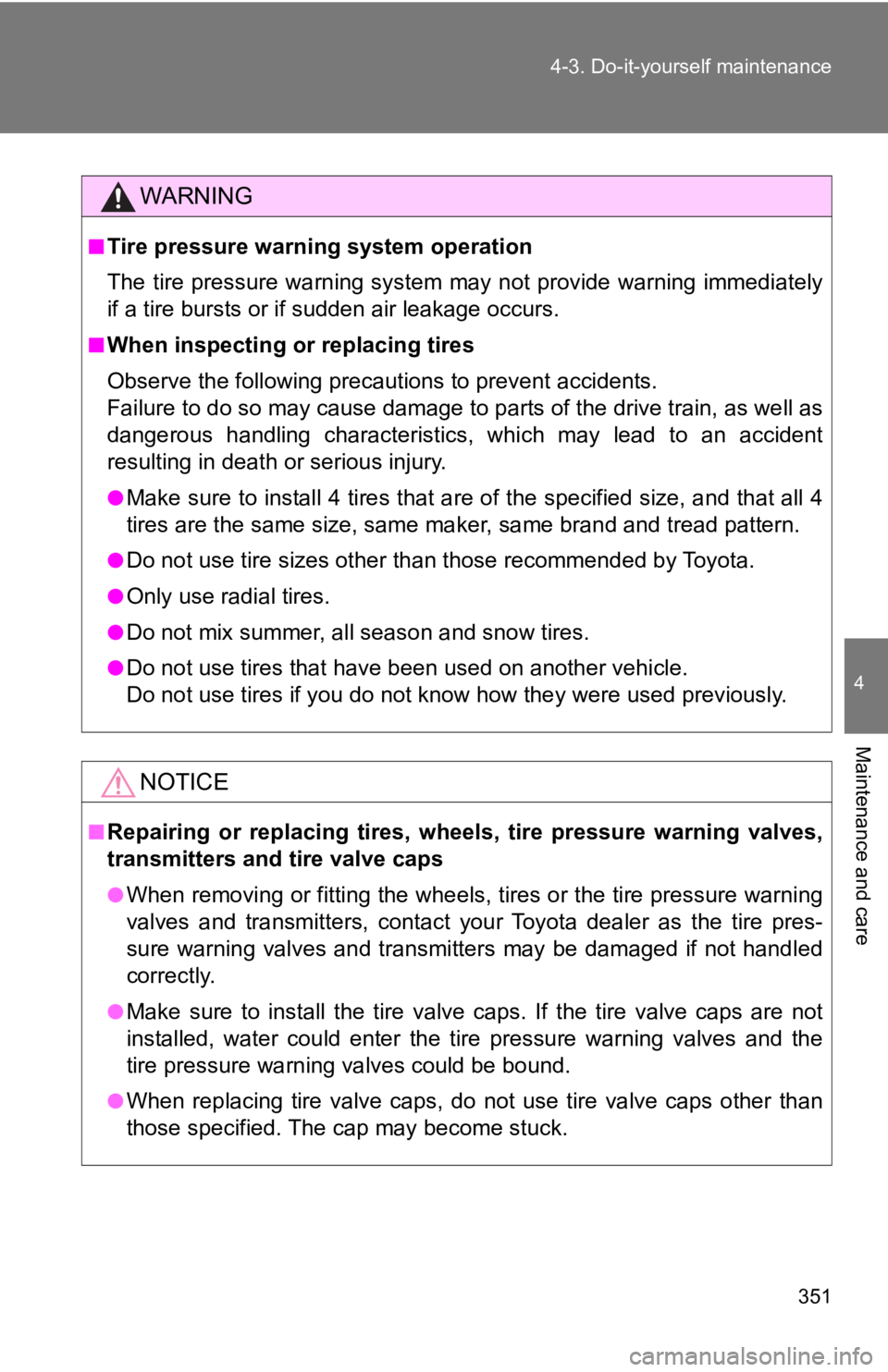
3514-3. Do-it-yourself maintenance
4
Maintenance and care WARNING■
Tire pressure warning system operation
The tire pressure warning system may not provide warning immedi ately
if a tire bursts or if sudden air leakage occurs.■
When inspecting or replacing tires
Observe the following precautions to prevent accidents.
Failure to do so may cause damage to parts of the drive train, as well as
dangerous handling characteristics, which may lead to an accide nt
resulting in death or serious injury. ●
Make sure to install 4 tires that are of the specified size, an d that all 4
tires are the same size, same ma ker, same brand and tread patte rn.●
Do not use tire sizes other t han those recommended by Toyota.●
Only use radial tires.●
Do not mix summer, all season and snow tires.
●
Do not use tires that have be en used on anot her vehicle.
Do not use tires if you do not kno w how they were used previous ly.
NOTICE■
Repairing or replacing tires, wheels, tire pressure warning val ves,
transmitters and tire valve caps
●
When removing or fitting the wheels, tires or the tire pressure warning
valves and transmitters, contact your Toyota dealer as the tire pres-
sure warning valves and transmitters may be damaged if not hand led
correctly.
●
Make sure to install the tire valve caps. If the tire valve cap s are not
installed, water could enter the tire pressure warning valves a nd the
tire pressure warning valves could be bound.
●
When replacing tire valve caps, do not use tire valve caps othe r than
those specified. The c ap may become stuck.
Page 353 of 532
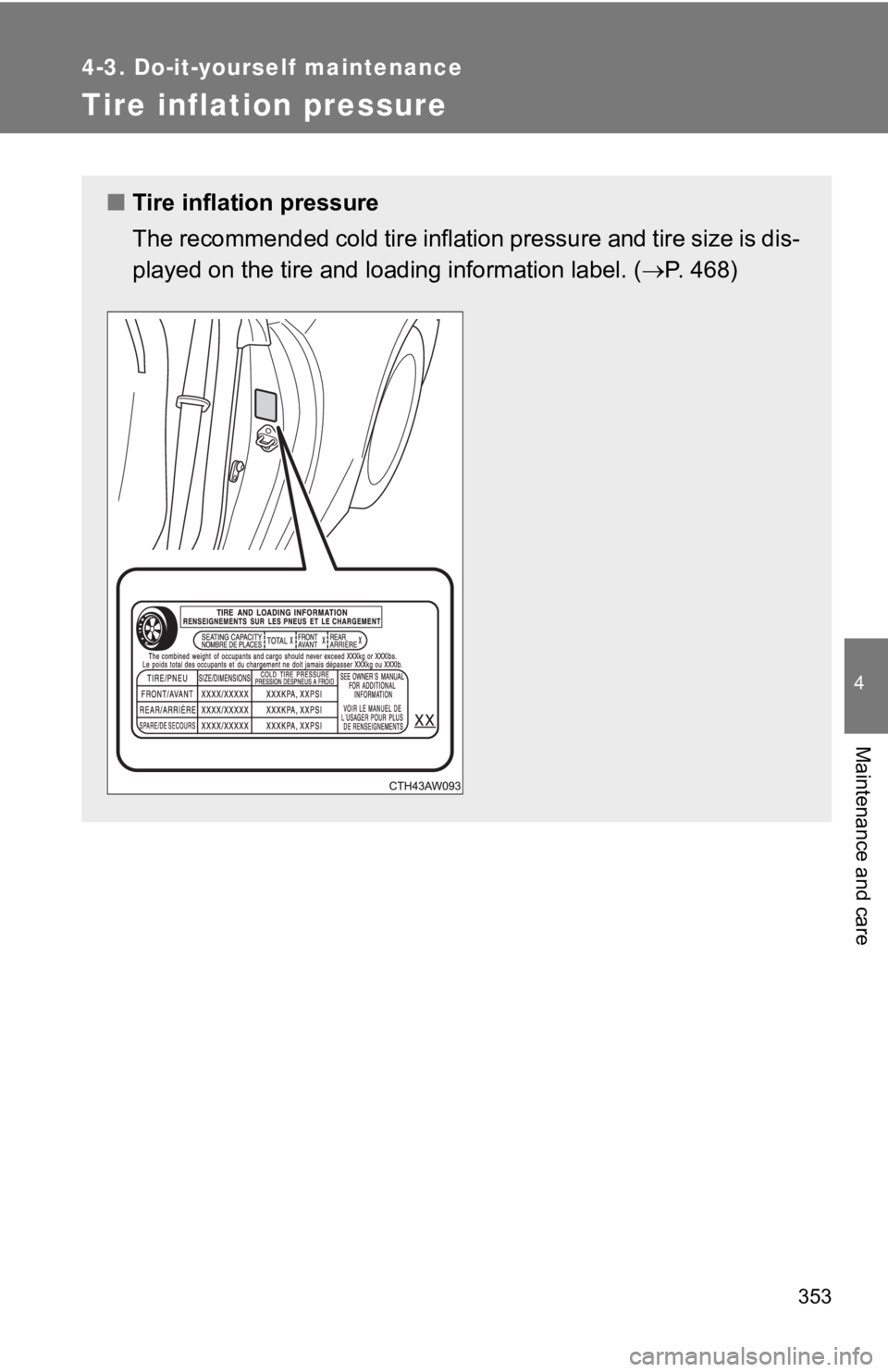
3534-3. Do-it-yourself maintenance
4
Maintenance and care
Tire inflation pressure ■ Tire inflation pressure
The recommended cold tire inflation pressure and tire size is d is-
played on the tire and loading information label. ( P. 4 6 8 )
Page 357 of 532
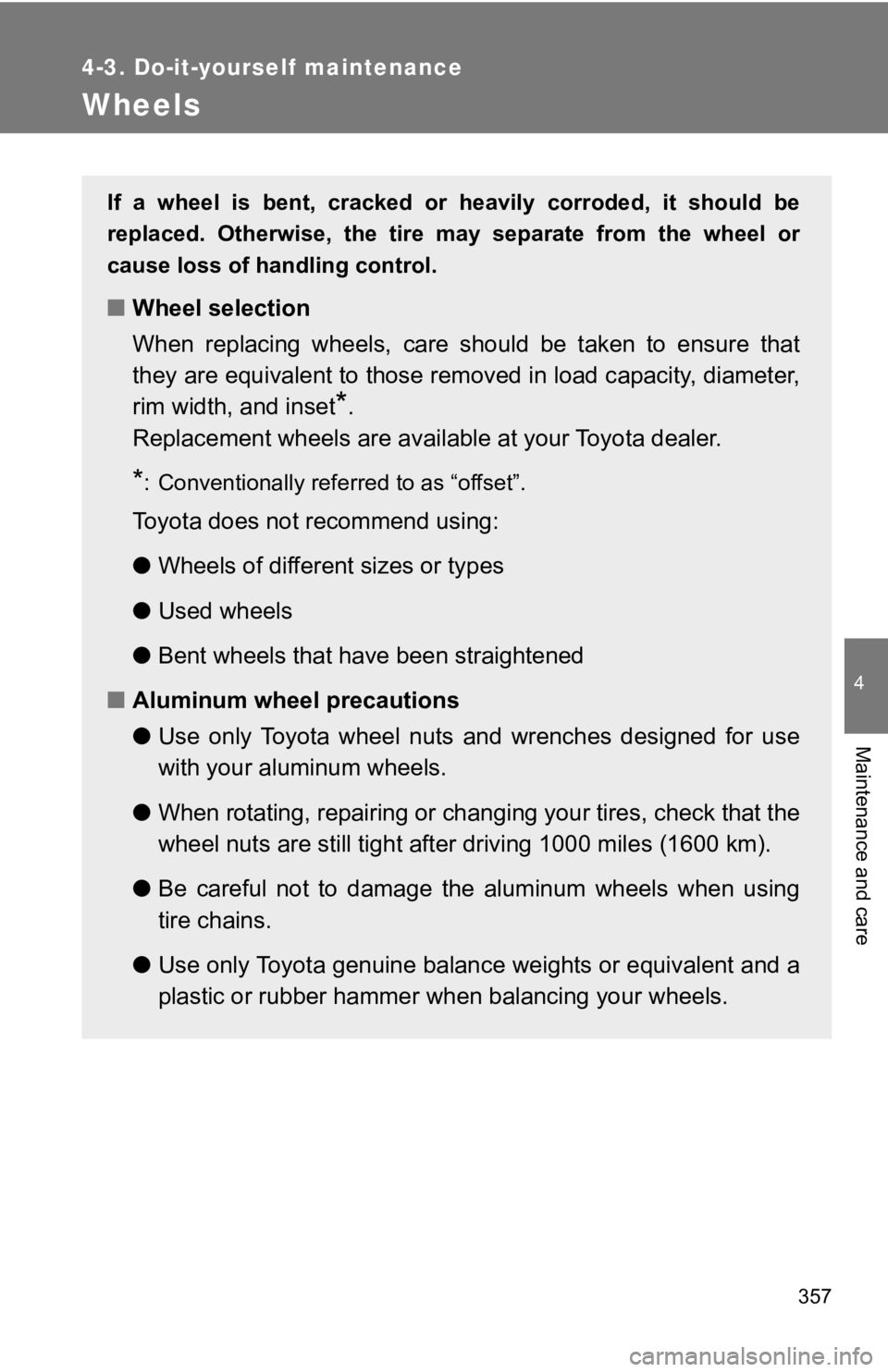
3574-3. Do-it-yourself maintenance
4
Maintenance and care
Wheels If a wheel is bent, cracked or heavily corroded, it should be
replaced. Otherwise, the tire may separate from the wheel or
cause loss of handling control.
■ Wheel selection
When replacing wheels, care should be taken to ensure that
they are equivalent to those removed in load capacity, diameter ,
rim width, and inset
* .
Replacement wheels are avail able at your Toyota dealer.
* : Conventionally refer red to as “offset”.
Toyota does not recommend using:
● Wheels of different sizes or types
● Used wheels
● Bent wheels that have been straightened
■ Aluminum wheel precautions
● Use only Toyota wheel nuts and wrenches designed for use
with your aluminum wheels.
● When rotating, repairing or chang ing your tires, check that the
wheel nuts are still tight afte r driving 1000 m iles (1600 km).
● Be careful not to damage the aluminum wheels when using
tire chains.
● Use only Toyota genuine balan ce weights or equivalent and a
plastic or rubber hammer when balancing your wheels.
Page 358 of 532
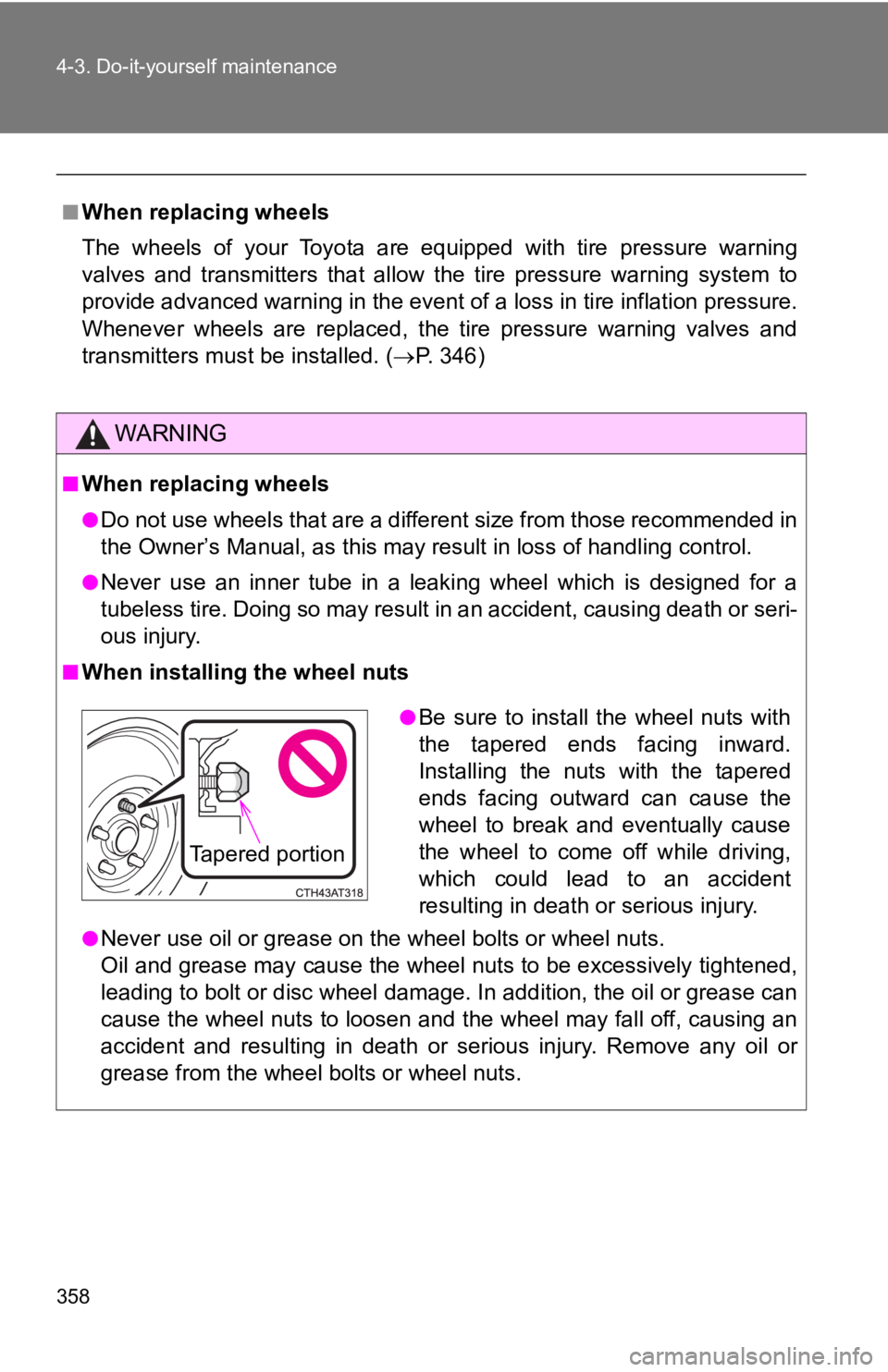
3584-3. Do-it-yourself maintenance
■
When replacing wheels
The wheels of your Toyota are equipped with tire pressure warni ng
valves and transmitters that allow the tire pressure warning sy stem to
provide advanced warning in the event of a loss in tire inflati on pressure.
Whenever wheels are replaced, the tire pressure warning valves and
transmitters mus t be installed. ( P. 3 4 6 )
WARNING■
When replacing wheels ●
Do not use wheels that are a different size from those recommen ded in
the Owner’s Manual, as this may result in loss of handling cont rol.●
Never use an inner tube in a leaking wheel which is designed fo r a
tubeless tire. Doing so may result in an accident, causing deat h or seri-
ous injury.
■
When installing the wheel nuts
●
Never use oil or grease on the wheel bolts or wheel nuts.
Oil and grease may cause the wheel nuts to be excessively tight ened,
leading to bolt or disc wheel damage. In addition, the oil or g rease can
cause the wheel nuts to loosen and the wheel may fall off, caus ing an
accident and resulting in death or serious injury. Remove any o il or
grease from the wheel bolts or wheel nuts. ●
Be sure to install the wheel nuts with
the tapered ends facing inward.
Installing the nuts with the tapered
ends facing outward can cause the
wheel to break and eventually cause
the wheel to come off while driving,
which could lead to an accident
resulting in death or serious injury.Tapered portion